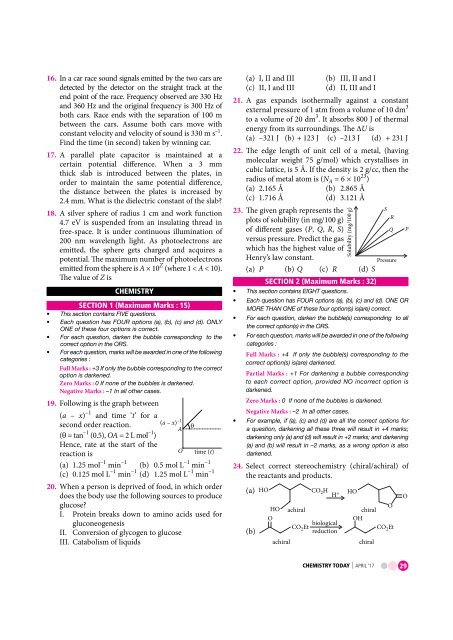Chemistry_Today_April_2017_vk_com_stopthepress
You also want an ePaper? Increase the reach of your titles
YUMPU automatically turns print PDFs into web optimized ePapers that Google loves.
16. In a car race sound signals emitted by the two cars are<br />
detected by the detector on the straight track at the<br />
end point of the race. Frequency observed are 330 Hz<br />
and 360 Hz and the original frequency is 300 Hz of<br />
both cars. Race ends with the separation of 100 m<br />
between the cars. Assume both cars move with<br />
constant velocity and velocity of sound is 330 m s –1 .<br />
Find the time (in second) taken by winning car.<br />
17. A parallel plate capacitor is maintained at a<br />
certain potential difference. When a 3 mm<br />
thick slab is introduced between the plates, in<br />
order to maintain the same potential difference,<br />
the distance between the plates is increased by<br />
2.4 mm. What is the dielectric constant of the slab?<br />
18. A silver sphere of radius 1 cm and work function<br />
4.7 eV is suspended from an insulating thread in<br />
free-space. It is under continuous illumination of<br />
200 nm wavelength light. As photoelectrons are<br />
emitted, the sphere gets charged and acquires a<br />
potential. The maximum number of photoelectrons<br />
emitted from the sphere is A × 10 Z (where 1 < A < 10).<br />
The value of Z is<br />
CHEMISTRY<br />
SECTION 1 (Maximum Marks : 15)<br />
• This section contains FIVE questions.<br />
• Each question has FOUR options (a), (b), (c) and (d). ONLY<br />
ONE of these four options is correct.<br />
• For each question, darken the bubble corresponding to the<br />
correct option in the ORS.<br />
• For each question, marks will be awarded in one of the following<br />
categories :<br />
Full Marks : +3 If only the bubble corresponding to the correct<br />
option is darkened.<br />
Zero Marks : 0 If none of the bubbles is darkened.<br />
Negative Marks : –1 In all other cases.<br />
19. Following is the graph between<br />
(a – x) –1 and time ‘t’ for a<br />
second order reaction.<br />
(q = tan –1 (0.5), OA = 2 L mol –1 )<br />
Hence, rate at the start of the<br />
reaction is<br />
( a–x ) –1<br />
A<br />
<br />
O time () t<br />
(a) 1.25 mol –1 min –1 (b) 0.5 mol L –1 min –1<br />
(c) 0.125 mol L –1 min –1 (d) 1.25 mol L –1 min –1<br />
20. When a person is deprived of food, in which order<br />
does the body use the following sources to produce<br />
glucose?<br />
I. Protein breaks down to amino acids used for<br />
gluconeogenesis<br />
II. Conversion of glycogen to glucose<br />
III. Catabolism of liquids<br />
(a) I, II and III (b) III, II and I<br />
(c) II, I and III (d) II, III and I<br />
21. A gas expands isothermally against a constant<br />
external pressure of 1 atm from a volume of 10 dm 3<br />
to a volume of 20 dm 3 . It absorbs 800 J of thermal<br />
energy from its surroundings. The DU is<br />
(a) –321 J (b) + 123 J (c) –213 J (d) + 231 J<br />
22. The edge length of unit cell of a metal, (having<br />
molecular weight 75 g/mol) which crystallises in<br />
cubic lattice, is 5 Å. If the density is 2 g/cc, then the<br />
radius of metal atom is (N A = 6 × 10 23 )<br />
(a) 2.165 Å<br />
(b) 2.865 Å<br />
(c) 1.716 Å<br />
(d) 3.121 Å<br />
23. The given graph represents the<br />
S<br />
plots of solubility (in mg/100 g)<br />
R<br />
of different gases (P, Q, R, S)<br />
Q P<br />
versus pressure. Predict the gas<br />
which has the highest value of<br />
Henry’s law constant.<br />
Pressure<br />
(a) P (b) Q (c) R (d) S<br />
SECTION 2 (Maximum Marks : 32)<br />
• This section contains EIGHT questions.<br />
• Each question has FOUR options (a), (b), (c) and (d). ONE OR<br />
MORE THAN ONE of these four option(s) is(are) correct.<br />
• For each question, darken the bubble(s) corresponding to all<br />
the correct option(s) in the ORS.<br />
• For each question, marks will be awarded in one of the following<br />
categories :<br />
Full Marks : +4 If only the bubble(s) corresponding to the<br />
correct option(s) is(are) darkened.<br />
Partial Marks : +1 For darkening a bubble corresponding<br />
to each correct option, provided NO incorrect option is<br />
darkened.<br />
Zero Marks : 0 If none of the bubbles is darkened.<br />
Negative Marks : –2 In all other cases.<br />
• For example, if (a), (c) and (d) are all the correct options for<br />
a question, darkening all these three will result in +4 marks;<br />
darkening only (a) and (d) will result in +2 marks; and darkening<br />
(a) and (b) will result in –2 marks, as a wrong option is also<br />
darkened.<br />
24. Select correct stereochemistry (chiral/achiral) of<br />
the reactants and products.<br />
(a) HO<br />
(b)<br />
HO<br />
O<br />
achiral<br />
achiral<br />
CO Et 2<br />
Solubility (mg/100 g)<br />
CO 2 H HO<br />
H +<br />
biological<br />
reduction<br />
O<br />
chiral<br />
OH<br />
CO2Et<br />
chiral<br />
O<br />
CHEMISTRY TODAY | APRIL ‘17 29


